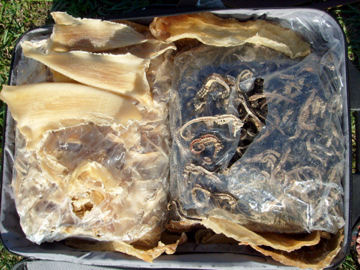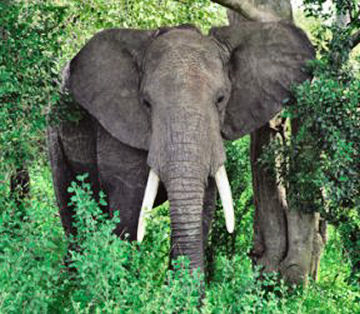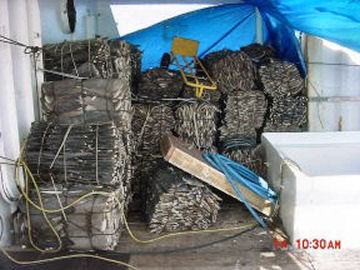Animal CSI or from science lab to crime lab
Scientists are finding new ways to help stop poachers from hunting endangered animals.
By Emily Sohn
Robbery, vandalism, murder: Crimes happen every day. But people aren’t the only victims of illegal activity. Bad guys can also target animals. And since animals can’t tell police officers what they’ve seen, these are some of the toughest cases to solve.
Particularly challenging are the crimes that involve poaching—taking animals from the wild that are protected by law. Poachers can make a lot of money selling meat, tusks, fur, fins, and other parts of protected animals.
 |
|
Federal inspectors took this suitcase from a traveler passing through Miami’s airport. Inside were poached shark fins and seahorses that NOAA enforcement officers later sent to researchers at Nova Southeastern University in Florida for identification.
|
| R. Horn/Nova Southeastern Univ. Oceanographic Ctr. |
Poaching can devastate even large wildlife populations if too many animals are taken in any year or from any area. The problem becomes even more serious when a species is endangered. Then, losing even a few animals can make it harder for the species to survive.
What’s really bad is that poaching creates an unfortunate cycle: As the animals become more rare, their parts become more valuable. So, poachers earn even greater rewards for their collection of protected species.
Now, scientists are helping fight back. Using the genetic material DNA, they are finding ways to clinch hard-to-solve cases involving a wide range of creatures, from elephants to seahorses.
If you’ve ever read a legal thriller or watched shows on TV such as CSI: Crime Scene Investigation, you know that DNA plays a big part in solving human crimes. The molecule appears in every cell. Like fingerprints, DNA is unique to every person. So, by analyzing DNA in blood, saliva, or hair left behind at the scene of a crime, detectives can identify criminals and victims.
When authorities find poached animal parts, they aren’t usually interested in identifying individual creatures. Instead, they want to know what species the parts belong to. That may not be obvious if all you have is a bit of meat, bone, or perhaps a fish fin. DNA can also prove helpful in figuring out where an animal came from. That’s because members of one local group of animals tend to share more DNA in common with each other than they do with more distant groups of their species.
Based on concepts such as these, scientists are developing new tests to untangle complicated webs of animal-related crime.
Tusk trackers
Elephants have been particularly devastated by poachers in recent decades. Between 1979 and 1987, poachers killed hundreds of thousands of wild elephants in Africa and Asia. This poaching reduced the animals’ numbers by more than half, says Samuel Wasser, director of the Center for Conservation Biology at the University of Washington, Seattle.
The motivation? Ivory. Elephant tusks are made of the hard, white material, which has long been used in jewelry and art, among other applications.
Poaching slowed down after an international ban on the ivory trade was passed in 1989. For a variety of reasons, however, the practice started creeping up again a few years later. By 2005, Wasser says, “the illegal ivory trade had come back with a vengeance.”
Even though it’s against the law to buy newly harvested ivory, people prize it so much that some are willing to buy it illegally. Such sales are said to be on the “black market.” In the past few years, the black-market price of ivory has quadrupled to about $850 per kilogram (2.2 pounds). A tusk can weigh 11 kg (24 pounds) or more.
Tens of thousands of elephants are dying each year as a result. There are fewer than 500,000 elephants living in the wild today.
Elephant poaching is hard to squelch because hunters often work in remote areas. Middlemen gather tusks from a variety of places. And well-hidden shipments follow complicated routes to destinations far from where they started. A single shipment can contain hundreds of tusks, thousands of pounds, and many millions of dollars worth of ivory.
Authorities intercept just 10 percent of these shipments, Wasser estimates. But even when officials retrieve the ivory, they usually don’t know where it came from.
To answer this question, Wasser has been looking for clues in elephant DNA. First, he collected elephant dung from 28 regions in 16 countries throughout Africa. He analyzed DNA in the dung samples. Then, he used the results to start mapping connections between an elephant’s DNA and its home range. Finally, he used statistics to fill in the blanks (see “Gene Sleuths Track Down Ivory Sources”).
“I’ve been working for 8 years on building this map,” Wasser says. “It has taken a while, but we’ve done it.”
But poachers trade tusks, not poop. And getting the genetic material out of ivory is more difficult. That’s because the outside of a tusk is made of dead cells, while the DNA is in living cells on the inside of the tusk. But smashing or drilling into the tusk destroys the DNA.
To overcome this problem, Wasser developed a way to extract DNA from ivory under supercold conditions. With liquid nitrogen, he was able to freeze the material. Then, he used a magnet and alternating magnetic fields to grind up the sample without destroying the DNA.
Using the technique, Wasser helped trace the origins of one of the largest ivory seizures ever made. The shipment, which contained 13,000 pounds (5,900 kilograms) of ivory, was seized in Singapore in 2002.
Wasser’s analysis showed that nearly all the seized ivory had come from a small region in Zambia. It was an important discovery because wildlife officials originally thought the shipment’s contents had come from many different places.
 |
|
Investigators can use genetic techniques to trace tusks or their ivory back to the population of elephants from which they were poached.
|
| Photodisc |
Findings like these are helping authorities narrow the hunt for elephant hunters.
“DNA can really help us stop the [ivory] trade at its source,” Wasser says. “For the first time, we don’t just have information about shipping and receiving, but about where the ivory comes from. This has completely changed the way law enforcement thinks about how to deal with these cases.”
Something’s fishy
Authorities are also getting better at nabbing shark poachers, thanks to Mahmood Shivji, a conservation geneticist at a shark conservation consortium at Nova Southeastern University’s Oceanographic Center in Dania Beach, Fla. Trained as both an oceanographer and geneticist, Shivji is now a DNA detective of the sea.
There are more than 400 species of sharks in the world’s oceans, Shivji says. Fishermen kill about 50 of those fish species for their fins, which people eat. The fins of some species are especially valuable. Sometimes sharks are also killed for their meat.
As a result of hunting pressures, shark numbers have dropped 70 percent in the past 2 decades. Many populations are now threatened and a few are even endangered.
It is legal to fish for most sharks, especially if the fish will be sold for meat. However, most sharks are killed for their fins—not meat. Fishers haul in the animals, slice off their fins and then throw the rest of the still living shark back in the water to slowly die.
It’s gruesome. It’s also a tremendous waste of majestic animals that help keep ocean ecosystems healthy. That’s why it is now illegal to kill a shark in the United States—unless the entire animal is kept for sale. Any ship containing fins without the rest of the animal is automatically guilty of shark “finning”, an illegal activity (poaching).
 |
|
On Aug. 23, NOAA took possession of the “fishing boat” King Diamond II. Although it had no fishing gear on board, it was carrying 32 tons of rotting shark fins. Nearly all had been neatly bundled into roped bales. Shown here is just a tiny portion of the loot that had been stored on deck—presumably to retard further decay. The loot was taken into custody and the U.S. boat’s crew was arrested for illegal shark finning.
|
| U.S. Coast Guard |
To protect sharks from poachers, Shivji says, authorities must first figure out which species are being hit hardest. But that’s hard to do when the only evidence is fins—which pretty much look alike, regardless of which shark species they came from.
“Markets are supplied from all over the world,” he says. “No one is keeping track of whether populations in certain parts of the world are being overfished relative to other populations.”
With those two goals in mind, Shivji started by studying DNA from 70 shark species, including all the varieties that end up in the fin trade. He found a small region of DNA that differs between species. Then, he created a simple test that identifies species on the basis of DNA taken from a meat or fin sample.
Next, Shivji found a different region of DNA that varies between members of the same species. He developed another test that identifies whether a sand tiger shark, for example, came from the northwest Atlantic, the southwest Atlantic, Australia, or South Africa. Finally, he combined the two tests.
The biggest advantage of Shivji’s technique is that it spits out results quickly. In just 2 days, he says, he and his team can identify the sources, by geography and species, for 50 fins.
Right now, the rapid tests can reliably identify 30 shark species. And they can distinguish between geographic populations of two of those species—sand tiger sharks and porbeagle sharks.
Shivji is working on incorporating more groups into the tests. And he wants to make the process even faster by eventually replacing much of the work that humans do with robotic technologies.
 |
|
This Asian market boasts a range of shark fins sold by size and type. A recent estimate indicates that some 40 million sharks are harvested each year for their fins, which would translate into an estimated 1.7 million metric tons of dead sharks.
|
| Shelley C. Clarke/Imperial College London |
The technique has already helped solve a number of suspicious cases for the National Oceanic and Atmospheric Administration. NOAA’s Office for Law Enforcement is responsible for inspecting fishing boats that enter U.S. ports. Shivji is also working on cases in foreign waters and helping train foreign colleagues.
As the tests get better and faster, word is spreading that it might not be so easy to get away with shark poaching anymore.
“Now, fishermen can’t say, ‘They’re never going to be able to tell the difference'” between legal and illegal catches, Shivji says. This “is having a positive impact on reducing the amount of illegal activity.”
It usually takes a long time for basic research to make an impact in the real world, Shivji adds. But animal-DNA detective work has quickly made the transition from science lab to crime lab. Scientists are now doing similar work to protect seahorses, seals, and other animals.
If the world’s poaching victims could talk, they would probably thank these scientists for their detective work.







